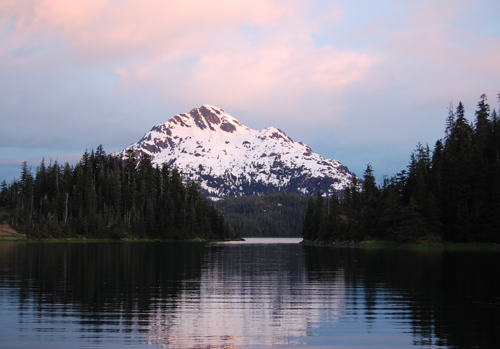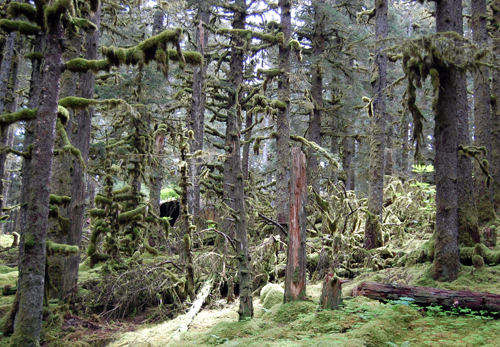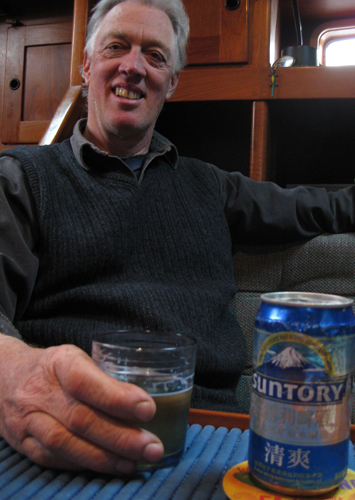Summer on Kodiak

The first three weeks of this summer's cruise was devoted to exploring new anchorages in Prince William Sound (PWS) and waiting for the weather to settle down to allow us to cross the frequently tempestuous northern Gulf of Alaska to Kodiak Island. We had spent two days on Kodiak last summer on our way east from the Alaskan Peninsula to PWS and planned on exploring the island group more extensively this summer.

As we left Cordova to cross over to the western side of the Sound, we were surprised by the amount of snow still lingering in the lower elevations of the mountains. In many anchorages there was still snow on the shore, and the lower valleys and streams remained heavily covered.

Typically, at this time of the year, the weather in the Sound seems to average three or four days of rain, then a day of partial sunshine before the cycle repeats. This season was no exception. Whenever the sky cleared we would go ashore to hike, if possible, and the rest of the time take excursions in the inflatable swaddled in our foul weather gear.
The two hundred mile crossing to Kodiak was accomplished easily, but without the view of the mountains and glaciers of the Kenai Peninsula often possible en-route, as the cloud cover extended to sea level.

Kodiak, of course, is the well known major fishing port known throughout the world. But it also is the home of the enormous Kodiak Brown Bear, the world's largest carnivore. In summer they descend the mountain sides from their winter dens, eating mostly the rich, dense grasses on the slopes. Later they beach comb along shore, and when the summer salmon runs begin, they gorge in preparation for the next winter. Much of our cruise would be devoted to watching bears, otters, seals, whales and birds, and the Kodiak islands affords an outdoor theater for animal entertainment.


During WWII, Long Island, located a few miles from the town of Kodiak, was completely occupied by the army as a site for coastal gun emplacements. The old roads that crisscrossed the island have grown over but now make great hiking trails. The trails wander through moss covered Sitka Spruce forests, and around small lily covered lakes - very enchanting. At strategic outcrops the remains of the gun emplacements and the barracks that supported them emerge from the mossy green Hobbit forest.


We left Long Island to explore the SE coast of the island group, an area not normally visited by pleasure boats.

Our first anchorage was in Shearwater Bay, located inside Kiliuda Bay, and the site of an old cannery that was destroyed by the tsunami created by the 1964 Alaskan earthquake. The anchorage is very well protected, tucked behind an outcrop of rocks and gravel spits. Every day we explored a different part of the bay, and each time we found the signs of bears (footprints and scat) but no animals. Finally we spotted a bear working the mud flats in a lagoon behind the spit. He watched us for a few minutes then turned around a ran away, snorting as he went.


We were visited one day by a family that runs a wilderness lodge further up Kiliuda Bay. They had been out collecting fire wood off the beaches, saw our masts, and stopped to see if we needed anything. We talked with them for about an hour and then they offered us a crab that they had caught that afternoon. As soon as they left we had that crab in the pot for dinner! Excellent!
We continued on towards Old Harbor, the only community on this part of the island. We had hoped to moor in it's small harbor, but on approach we found that the entrance was too shallow, so we abandoned that plan. The weather was such that we couldn't anchor in front of the village so we backtracked to MacDonald Lagoon, an anchorage reached through a narrow break in two shingle spits protecting the lagoon. To our enjoyment, a large bear was in residence in the crook of the lagoon just inshore of our anchorage.


On a long beach walk just outside the lagoon, we were—as always—amazed at the quantity of plastic jetsam washed ashore. In just a few meters of beach we collected a substantial pile. But included in this junk was a can of Japanese beer, intact though battered by an apparent lengthy ocean adventure. No English on the label indicated that it wasn't intended for export, but floated in on its own. When we returned to the boat, Mark enjoyed the first cold beer in some time. Bounty of the Sea!!

Mark has long been interested in the history of whaling, particularly in the Bering Sea and the Western Arctic. In the course of his readings he found a reference to the Port Hobron Whaling Station, which was established in 1915 and operated until 1930. Port Hobron is a small fjord not far from the village of Old Harbor, so we went in search of the station. We were not expecting to find much remaining, and were surprised to see most of the oil tanks and processing machinery still on site, the remains of a whale chaser boat on the beach, and the dilapidated superintendent's house. The site was very much the same as the one we visited in Hawk Harbor, Labrador.

By the time of World War I there were of course alternatives for whale oil as lighting, but it was still in use for specialized machinery, and was a primary source of glycerin. Glycerin of course is an ingredient in high explosives, and market demand was exceptionally high during the war. The meat and bone were dried and made into cattle feed and fertilizer. The long cylinders visible in the photographs are the remains of steam heated rotary screw driers.

As one sails west from the town of Kodiak, large trees begin to disappear, and the slopes are covered instead with some alder and cottonwood, and a verdant dense grass cover. Wild flowers of every color are interwoven in the grasses. Nancy spent hours on her knees photographing flowers—now she has to find a good book to find out their names.


Labels: Hobron Whale Station, Kodiak, Long Island, Prince William Sound, Shearwater Bay



2 Comments:
Kodiak looks great! They could shoot a "Lord Of The Rings" sequel there.
Cheers-
Bill and Lynn
Kodiak looks great! They could shoot a "Lord Of The Rings" sequel there.
Cheers-
Bill and Lynn
Post a Comment
<< Home